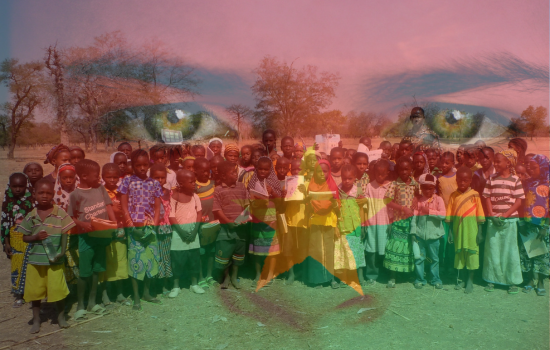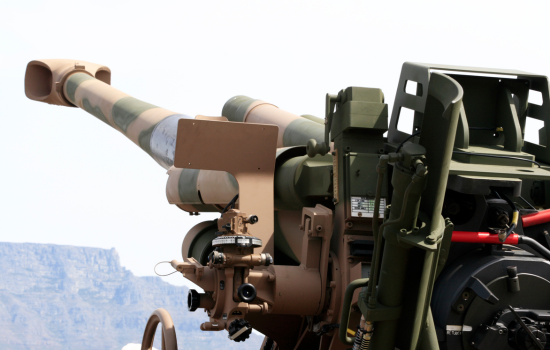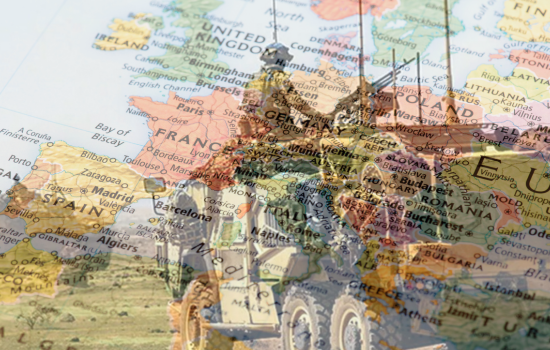The al-Aqsa Martyrs Brigades – A political tool with an edge
Last month, the United States Government added the Palestinian militant group al-Aqsa Martyrs Brigades to its list of Foreign Terrorist Organizations. The designation makes it illegal under U.S. law to provide material support to the organization and requires banks to freeze its assets. The move marked the first time the Bush administration has taken active steps against an organization directly linked to Palestinian Chairman Yasser Arafat.
The al-Aqsa Martyrs Brigades first emerged on the scene shortly after the outbreak of what has come to be known as the al-Aqsa conflict, in late September 2000. In a very real sense, the Martyrs Brigades was a response to the need to suit actions to words.
At the close of the Camp David talks, Palestinian leader Yasser Arafat, who had been offered a Palestinian state alongside of – but not instead of – Israel, declared that the Oslo Peace Process was at a dead end. At the time, the Fatah militias, consisting of the Fatah Tanzim, Force-17, and the various Palestinian security services, were still viewed, both by Israel and by the Palestinians themselves, as moderate forces. Ideologically, they supported what had been, up until then, the Palestinian leader’s stated goal of establishing a Palestinian state alongside Israel.
Over the past year and a half, these stated goals have undergone a change, and the nature of the Fatah-linked groups has altered accordingly. Since the outbreak of hostilities, Arafat has consistently preached “Jihad” against Israel. However, at first it was mostly the Islamist groups, Hamas and the Palestinian Islamic Jihad, that carried out the mass-casualty attacks inside Israel. The Tanzim, which lacked the resources for carrying out the kind of “professional” bombings typical of Hamas, confined itself to shooting attacks on Israelis on roads in the disputed territories.
All of this began to change towards the end of 2000, when Arafat ordered his security services to release the majority of the imprisoned Hamas and Islamic Jihad militants—many of them convicted terrorists who had been jailed under the terms of the Oslo agreements with Israel. Hamas was invited to join the Palestinian Authority’s governing body; and while the invitation was not accepted, a new level of cooperation between Fatah and Hamas began to take shape. The first joint attacks against Israeli civilians were not long in coming.
To date, the Fatah Tanzim and the Martyrs of al-Aqsa have taken responsibility for more than 300 terror attacks in which Israeli civilians were killed. Israeli authorities say that since September 2000 the Fatah-linked groups have carried out more than 1,500 attacks and attempted attacks, including car bombings, shootings, kidnappings, and knife attacks.
Arafat’s private militia
Military sources said that among the documents seized in a raid on Arafat’s headquarters was an invoice from the al-Aqsa Martyrs asking for reimbursement for, among other things, explosives used in bombings in Israeli cities. The document was addressed to Brig. Gen. Fouad Shoubaki, the Palestinian Authority’s chief financial officer for military operations, and contained numerous handwritten notes and calculations, apparently added by Shoubaki’s staff. (See Appendix, for translation.)
The document was the first direct proof of what the Israeli intelligence establishment has claimed for some time: the al-Aqsa Martyrs Brigades are not a “rogue militia” as Arafat claims. Rather its members are on the Palestinian Authority’s payroll, it activities are financed out of Palestinian Authority coffers, and its attacks are carried out with the knowledge and backing of Yasser Arafat’s inner circle.
The invoice was sent by the Al-Aqsa Martyrs Brigades to Shoubaki’s office, located in the Palestinian Authority’s headquarters in Ramallah. Dated 16 September, it outlines expenses through September 6 and asks Shoubaki’s office for money to build additional bombs, and to finance propaganda posters promoting suicide bombers.
The seven-point financial report lists the projected cost of various attack-related activities, including “electrical components and chemical supplies to produce charges and bombs.” The cost of each bomb was listed as $150. “We require on a weekly basis 5-9 explosives charges for squads in various areas,” the document read.
Also cited were the costs for printing posters of al-Aqsa members killed in conflict with Israelis, for printed announcements, invitations and mourners’ tents, for mounting “martyrs’ portraits” on boards, and for funerals. Another item asked for the transfer of $17,930 to cover purchases of AK-47 assault rifles.
Colonel Miri Eisen, a senior intelligence officer who presented the document, said that she did not have information on whether the transfer of funds was carried out. However, she pointed out the in the time since the letter was sent, the al-Aqsa Martyrs Brigade had carried out eight suicide bombings in Israel. In addition, the group has carried out about 300 attacks in which Israeli civilians were killed or wounded, including roadside ambushes, driveby shootings, and car bombings. “You could probably call this a terror invoice. How much does terrorism cost?” Eisen told reporters.
Nor is the involvement of Fouad Shoubaki in all of this particularly surprising. Shoubaki, a close associate of Arafat for more than 30 years, first rose to public prominence in the wake of the “Karin A Affair,” when it emerged that he had paid out some $200,000 for the purchase of a ship to haul weapons from Iran to the Palestinian Autonomous territories. The ship was seized by Israeli commandos on the Red Sea in January, and was found to be carrying some fifty tons of weapons in violation of Arafat’s agreements with Israel.
In a bid to deflate international criticism and distance himself from the affair, Yasser Arafat announced that Shoubaki would be fired from his post and tried for his role in arranging the arms deal. However, the arrest and proposed trial were widely considered to be public relations gestures.
Israeli military sources say that the many documents seized in Shoubaki’s office showed that he continued with “business as usual” after the Karin A affair. Shoubaki, also known as abu Hazm, is currently trapped with the Fatah leader in his Ramallah headquarters, which was surrounded by Israeli forces last week.
According to the Israeli military establishment, Shoubaki was also responsible for financing the activity of the al-Aksa Brigades in the Bethlehem region, transferring monthly salaries to the organization’s activists in the area. In addition, he was involved in purchasing a cache of weapons stolen towards the end of the year 2000 from an IDF base in the area. These weapons were later used to carry out attacks against Israeli civilians in the area of Jerusalem.
Dore Gold, an advisor to Prime Minister Ariel Sharon, said Tuesday that Shoubaki had visited Baghdad in August 2001 in order to coordinate positions with the Iraqi government, and that in May 2001 he was present at a meeting in Moscow during which the draft for joint activities between Iran and the PA was agreed upon.
Both Iraq and Iran have become increasingly involved in providing financial and military support to Palestinian groups since Arafat first declared the peace process at a dead end and returned to armed conflict. Iraqi president Saddam Hussein announced last week that he is increasing the sum offered the families of suicide bombings from $10,000 to $25,000, in order to encourage more young men to “choose the path of martyrdom.”
The emergence of the Islamic nationalists
Unlike the Hamas and the Islamic Jihad—the groups usually associated with mass-casualty attacks against Israel—the al-Aqsa Martyrs Brigade was at first thought of as a secular, nationalist group, rather than an Islamic one. Thus it came as something of a surprise when the group began carrying out suicide bombings. On hindsight, however, this appears as a natural step. Islamic motifs had been part of the “al-Aqsa” conflict from the beginning—the very name of the conflict was derived from the notion that Israel had plans to destroy the al-Aqsa Mosque. Religious motifs have been used extensively by Arafat in his diatribes against “Israeli occupation of Muslim holy places.” Thus, having made Islam-vs.-Judaism a central tenet of the war, it was natural for Fatah to alter its own character to suit the rhetoric that had launched the conflict and kept it going.
The Fatah movement, which controls the Palestinian government—and more importantly, the media and the schools—has generally enjoyed wider popularity than either of the more insular Islamist groups. The movement had lost ground during the earlier stages of the conflict, when the Palestinian leader’s rhetoric outstripped Fatah’s actions in confronting Israel. The popularity of the Islamic groups was given a boost when it appeared that only Hamas and the PIJ were acting to implement Arafat’s calls for “rivers of blood in the streets of Tel-Aviv.” However, in the past few months, the al-Aqsa group has almost completely eclipsed the Hamas and the Islamic Jihad, both in the number and in the deadliness of its attacks. The current predominance of the Martyrs of al-Aqsa in carrying out terrorist attacks in Israel has done much to restore Fatah’s popularity on the Palestinian “street.”
The question of Arafat’s control
The role of the Martyrs of al-Aqsa Brigades in rebuilding Fatah’s popularity has raised questions about Arafat’s power to restrain it. Many argue that any attempt by the Palestinian leader to rein in the militants now, when they are the key to his popularity, would only lead to a mutiny against his rule or to his assassination.
At the heart of Arafat’s dilemma is the need to continue to mobilize his society for conflict with Israel, despite the fact that he can present his people with no real achievements after eighteen months of the “intifada.” The ultimate victims of Palestinian terrorism have been the Palestinians themselves, due in large part to the failure of the Palestinian Authority to develop a self-sufficient economy. The livelihood of most Palestinians has always depended—directly or indirectly—on the earnings of Palestinians working in Israel. Since the outbreak of hostilities, Israel, fearful of terrorist attacks, has virtually closed its borders to Palestinian laborers. At the same time, tourism, a mainstay of both the Palestinian and the Israeli economies, has dropped to a trickle. Thus, Arafat is forced to continue to justify a war that, while saving him the need to address domestic concerns, has brought the Palestinian people nothing but grief.
His true dilemma is that only by continuing with his war can he maintain his popularity among his own people. His propaganda machine has done its work too well; at this point the Palestinians have been fed the story of the supposed Israeli plan to take over the Muslim world to the point where the majority actually seem to believe it. Any attempt by Arafat to put out the fire at this point would only erode his popularity and credibility. He cannot suddenly turn around and say to his own people, “Sorry, but most of what I’ve been telling you for the last two years was untrue! Now, after more than 1,000 of us have been martyred, we’re going to accept the Palestinian state that we were offered in 2000.”
Arafat’s problem is thus the need to justify an investment that has so far failed to deliver any profit at all. The same dilemma faces Arafat with respect to the activities of his own terrorist apparatus. Taken together, the Fatah groups enjoy the overwhelming support of Arafat’s constituency, and he has invested a great deal in keeping them armed and active, even while his civilian infrastructure languishes for lack of funds and attention. Meanwhile, the leaders of the al-Aqsa Martyrs insist that, while they hold Arafat in high esteem, they do not take their orders regarding individual attacks from him.
However, Israeli security officials maintain that Arafat exerts a large measure of control over all the Fatah-affiliated organizations, paying the salaries of their members and supplying them with weapons. And while he may not determine the target and timing of each individual attack, he definitely sets the overall agenda. In fact, this was true to a great extent even with regard to the “opposition” Islamist groups prior to the outbreak of hostilities. These organizations, while not directly controlled by Arafat, were still dependent upon his willingness to leave their military capabilities intact. Had he chosen to disarm and outlaw the Islamic Jihad and the armed wing of Hamas, the Islamists would have been largely marginalized.
Moreover, Arafat remains in control of the media. This means that while Arafat’s credibility with his own people may suffer some erosion, his position as a symbol is unassailable. His popularity may be expected to weather the storm, if only because by controlling the media, Arafat controls the standards of popularity. From the outset, it was the official messages, disseminated through the radio, television and the PA-salaried preachers, that most strongly influenced the thinking of the Palestinian street. Terrorist attacks, formerly portrayed as a politically counter-productive tool to be used only as a last resort, are now hailed as the pinnacle of glory in the Palestinian cause. Having sold martyrdom as the highest goal for which every Palestinian child should strive, Arafat has been forced to match his actions (or at least the actions of those who take his orders) to his words.
However, just as the media was used to fuel the hatred of the Palestinian in the street, it could also be used to sell coexistence and the benefits of peace. While it may be argued that, for the younger generation raised on a steady diet of hatred, the damage is irreversible, this probably does not apply to the generation currently most active in the violence.
While the degree to which Arafat controls the Tanzim—and the al-Aqsa Martyrs Brigades—is still subject to debate, most analysts are in agreement that his control is much greater than he makes it out to be. And while restoring calm may be a daunting task, it is nevertheless one within reach. However, it now appears unlikely that Yasser Arafat will choose to put out a fire that he has so carefully fed with the bodies of his own people. Rather than being recorded in history as the leader who agreeed to a state on only part of historic Palestine, Arafat is likely to choose to prolong the conflict indefinitely. It will be left to his successors to undo the damage that he has done.
Appendix
| The following is the English translation of a routine invoice from the al-Aqsa Martyrs Brigade to the Office of Fouad Shoubaki, Yasser Arafat’s chief financial officer for military expenses. The handwritting in the margins is thought to be that of Shoubaki himself.
Source: IDF Spokesperson’s Office |
| Fouad Shoubaki Office’s handling of the “Al Aqsa Martyrs Brigades” Request for Financial Aid
Al Aqsa Martyrs Brigades
Financial Report The debts which we have accumulated until now are estimated to be NIS 38,000. The following are the details: 1. The cost of posters of the Al Aqsa Martyrs Brigades: Azam Mazhar, Usama Jubara, Shadi Afuri, Yasser Badawi, Ahed Fares (addition in handwriting of 2,000 shekels). 2. Costs of printed announcements, invitations and mourners shelters for martyrs (addition in handwriting of 1,250 shekels). 3. Cost of sticking photos of martyrs on wooden boards and also of the martyrs Thabet Thabet and Mahmud Al Jamil (addition in handwriting of 1,000 shekels). 4. Cost of memorial ceremonies for the martyrs. Memorial ceremonies were held for the martyr Azam and the martyr Usama (addition in handwriting of 6,000 shekels). 5. Costs of electricity products and various chemical materials (for manufacture of explosive charges and bombs). This is the greatest expenditure (the cost of one ready explosive charge is 700 shekels at least). We require on a weekly basis 5 – 9 explosives charges for squads in various areas (addition in handwriting of 5,000 shekels per week x 4 = 20,000 shekels per month). 6. The cost of bullets. The cost of a Kalashnikov bullet is 7 – 8 shekels, and an M-16 bullet costs 2 – 2.5 shekels. We need bullets on a daily basis. 7. Note: there are 3,000 Kalashnikov bullets at a cost of 2 shekels per bullet. We require that you transfer to us immediately a sum of money for us to purchase them (addition in handwriting of 22,500 shekels for kalashnikov bullets and 60,000 shekels for M-16 bullets). In conclusion, all the glory and pride to those supporting the brave resistance against the oppressive occupation. From the revolution until victory. Palestinian Al Aqsa Martyrs Brigades Addition in handwriting: 25,000 Dinar = 150,750:6
|






